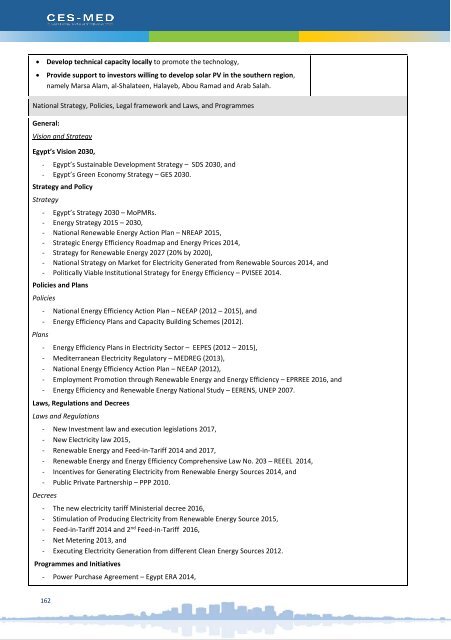020318_Hurghada SECAP_FINAL
Create successful ePaper yourself
Turn your PDF publications into a flip-book with our unique Google optimized e-Paper software.
Red Sea. The GRP will also increase the use of RE to improve the Governorate’s sustainable energy prospectus, yet<br />
contribute to achieving Egypt’s Vision and National Sustainable Development Strategy (SDS) 2030.<br />
Implementation plan<br />
Component 1:<br />
Phase 1: Setting up the EAU – Allocating staff – Installing basic equipment,<br />
Phase 2: Priority programme targeting municipality staff with basic information on climate change and energy:<br />
- Reduce artificial lighting and take advantage of daylight,<br />
- Manage temperature inside buildings to reduce use of AC/heater,<br />
- Shut down electric equipment at end of working time, and<br />
- Remove electrical pins from electrical socket when the day ends.<br />
Phase 3: Develop a specific programme “GRP”, mobilising women and household owners. Thus, mainly focus on:<br />
- Promote the apt temperature set at home: usually homes consume large amount of energy I summer<br />
when a reasonable cooling/ heating temperature can result in 20-30 per cent cut in energy use,<br />
- Foster behavioural changes at home: turning off lights when not in use, good management of refrigerator,<br />
washing machines’ time of use, boiling waters in kettles, and replacing classical bulbs with efficient devices<br />
such as LED lamps,<br />
- Advance use of energy efficient cooling/ heating devices: with good devices enough to ensure efficient<br />
performance. People usually buy inexpensive equipment without taking into account the higher level of<br />
energy consumption – even with green labelling devices act, this could lower energy consumption, but<br />
more awareness is needed to emphasise on buying green label appliances,<br />
- Control elevators’ use: set operation programme and limit their use to 3 rd floor unless users have medical<br />
issue/problems,<br />
- Adjust Air conditioning systems’ thermostats: be always at 24 degrees Celsius in summer, which would<br />
save up to 25 per cent of the energy consumption, and<br />
- Apply 3M sheets on windows’ glass/glazing: would reduce the impact of solar radiation impinging on the<br />
external buildings’ façades, reduce cooling loads, and lower energy consumption.<br />
A rough calculation allows considering that a widespread awareness campaign could result in a 20 per cent reduction of<br />
electricity consumption (estimation being more difficult on other fluids) in 50 per cent of households and private<br />
buildings.<br />
Component 2: The plan is to develop solar PV and SWH wherever possible and appropriate in residential buildings. All<br />
combinations are possible, from small 5kW units on a roof to larger units of 200kW or even more when surface available<br />
allows it. Such project should focus on few measures:<br />
- Promote the use of SWH systems instead of the current electric water heating (EWH) systems. Currently, in<br />
most of residential buildings EWH systems are used instead of SWH due to low cost electricity tariff during 2010-<br />
2015. With the increased in tariffs, this action could tremendously reduce electricity consumption.<br />
- Develop a partnership with a bank acting as a “third party investor” that will support the investment solar energy<br />
units’ installation (for example through a process where the bank will cover the cost of the loan from a part of<br />
the savings allowed by the installation of PV and SWH programme),<br />
- Involve and train staff and companies that provide and sell PV and SWH systems to identify the benefits of<br />
installing the SWH instead of the EWH. The price of the SWH can be calculated and deducted virtually from the<br />
monthly electricity bill and given to the company as it represents the amount of saving. This could be done for<br />
2-3 years; the occupants will own the SWH after that period and will eventually save money due to this<br />
installation.<br />
Component 3: On the long term, it would be necessary to develop a renovation programme targeting less energy efficient<br />
building, where basic buildings envelop insulation could significantly reduce energy use while improve comfort. To<br />
154

















